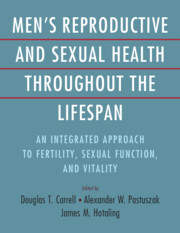 Men's Reproductive and Sexual Health Throughout the Lifespan
Men's Reproductive and Sexual Health Throughout the Lifespan from Section 5 - Medical and Surgical Management of Issues of Male Health
Published online by Cambridge University Press: 06 December 2023
The worldwide prevalence of erectile dysfunction is estimated to impact 20% of men. The evaluation of the male with erectile dysfunction can serve as an opportunity to screen men for a variety of important cardiovascular risk factors. A typical visit consists of a detailed and comprehensive patient history and a focal physical exam. Patients should be put at ease and a therapeutic relationship established to move forward with a shared decision-making process regarding treatment. Considerations during the evaluation should be toward screening for underlying risks factors for erectile dysfunction, a detailed sexual history, utilization of validated questionnaires, determination of lifestyle and social history factors, basic laboratory testing, and a psychological assessment. The goal of the evaluation is to identify the underlying causes of erectile dysfunction that will allow the clinician to develop the best therapeutic strategy.
To save this book to your Kindle, first ensure [email protected] is added to your Approved Personal Document E-mail List under your Personal Document Settings on the Manage Your Content and Devices page of your Amazon account. Then enter the ‘name’ part of your Kindle email address below. Find out more about saving to your Kindle.
Note you can select to save to either the @free.kindle.com or @kindle.com variations. ‘@free.kindle.com’ emails are free but can only be saved to your device when it is connected to wi-fi. ‘@kindle.com’ emails can be delivered even when you are not connected to wi-fi, but note that service fees apply.
Find out more about the Kindle Personal Document Service.
To save content items to your account, please confirm that you agree to abide by our usage policies. If this is the first time you use this feature, you will be asked to authorise Cambridge Core to connect with your account. Find out more about saving content to Dropbox.
To save content items to your account, please confirm that you agree to abide by our usage policies. If this is the first time you use this feature, you will be asked to authorise Cambridge Core to connect with your account. Find out more about saving content to Google Drive.